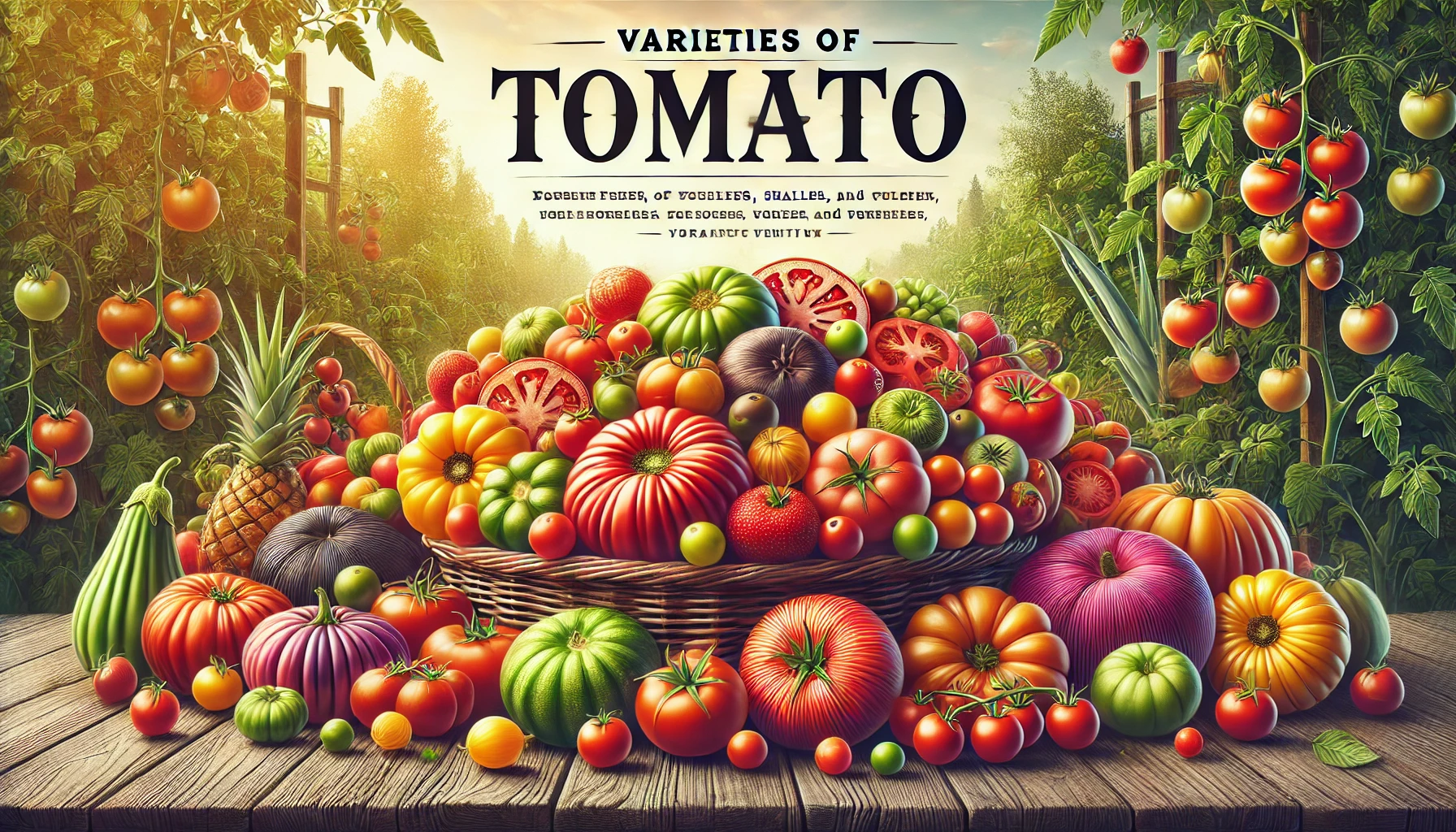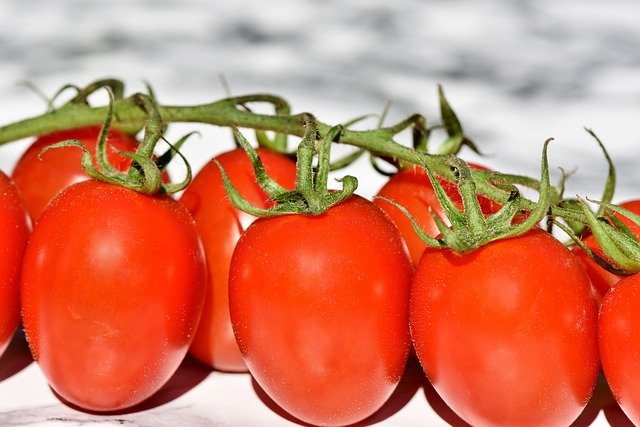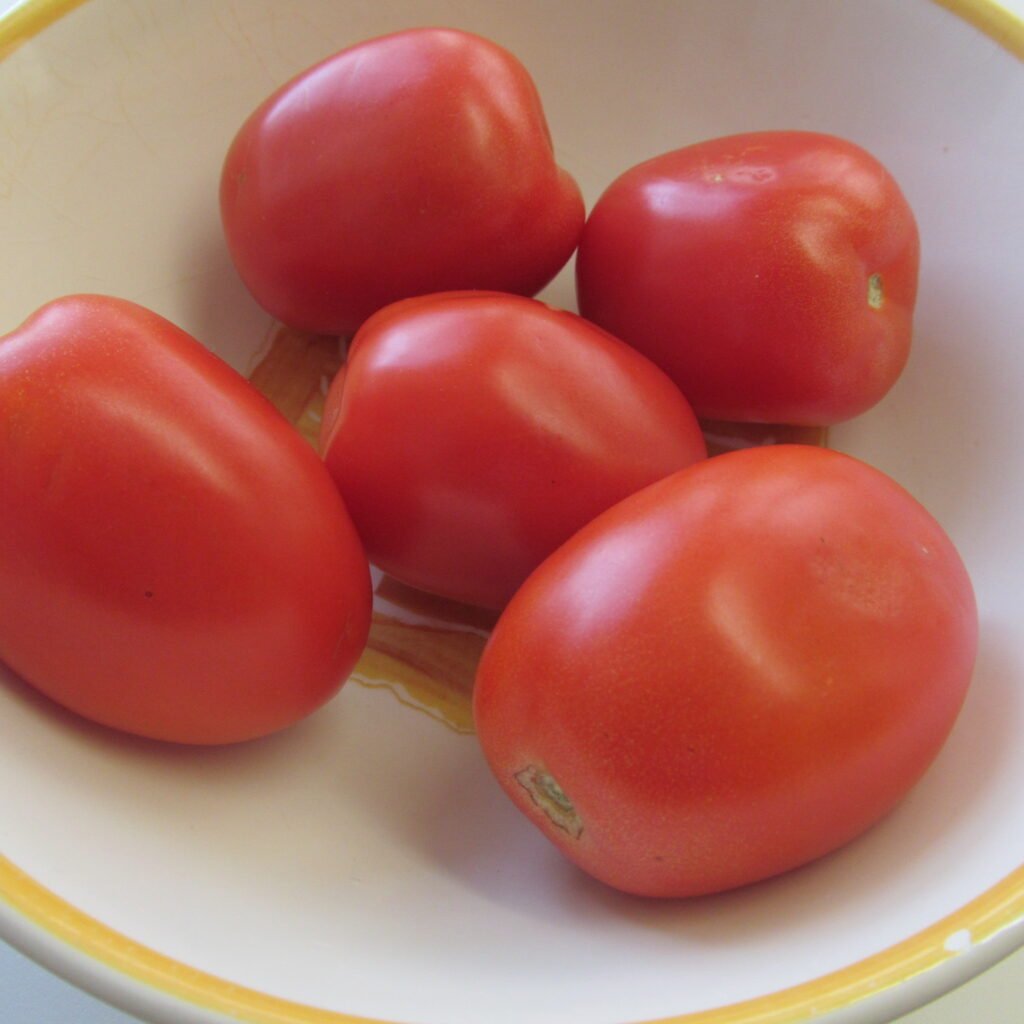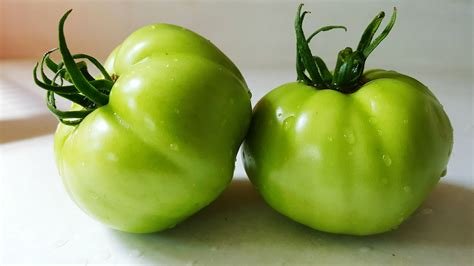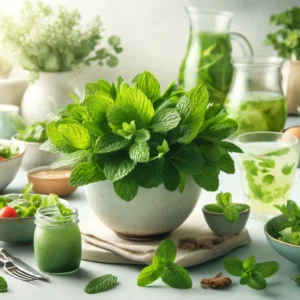Tomatoes come in a wide range of varieties, each with unique characteristics that cater to different gardening preferences and culinary uses. Whether you are growing tomatoes in a garden, raised bed, or container, selecting the right variety is crucial for achieving the best results. Here are some popular tomato varieties, along with their specialties, advantages, and disadvantages.
Varieties of Tomato
1. Beefsteak Tomatoes
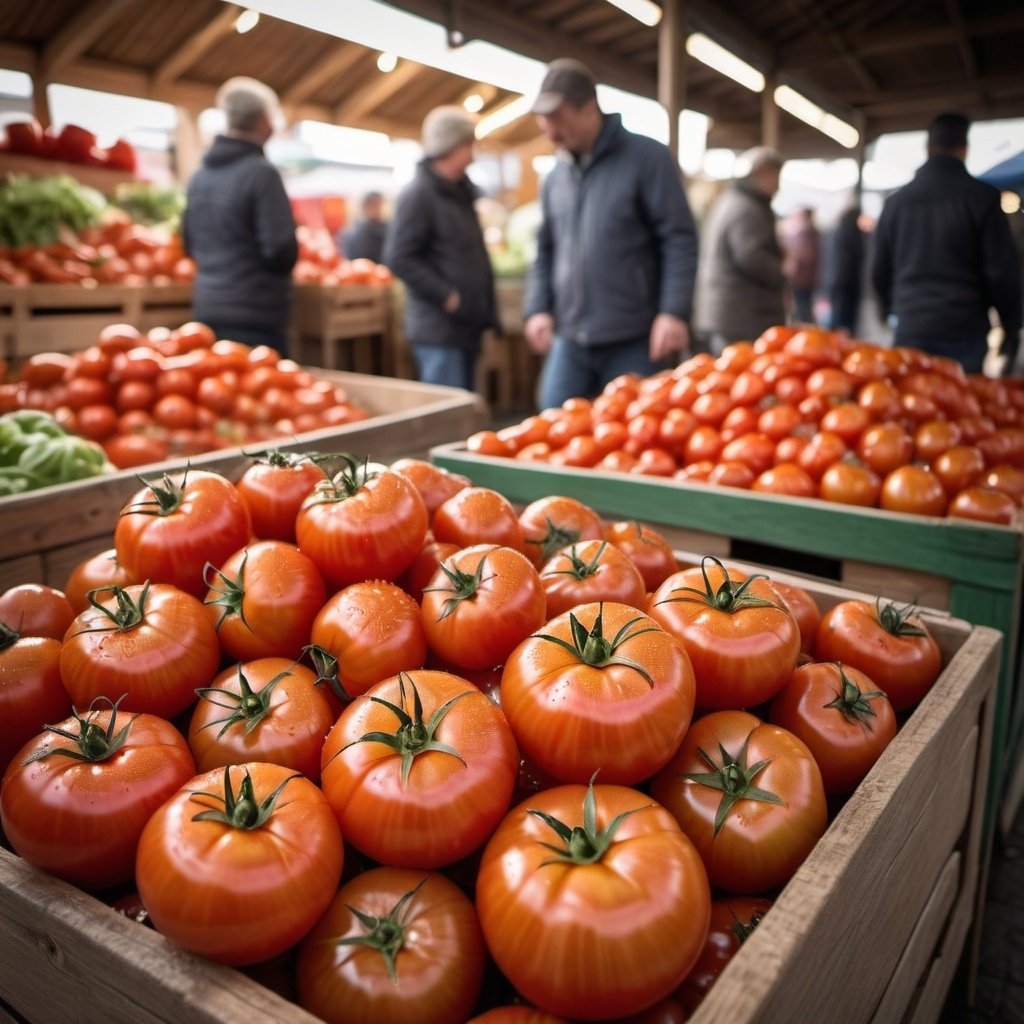
Characteristics of Beefsteak Tomatoes:
- Large Size: They typically grow into hefty fruits, often weighing over a pound each, making them ideal for slicing and adding to sandwiches or burgers.
- Meaty Texture: Beefsteak tomatoes have dense flesh with fewer seeds, giving them a substantial and satisfying texture when eaten fresh or cooked.
- Rich Flavor: These tomatoes are prized for their bold and robust taste, often described as sweet with a hint of acidity, making them perfect for salads, salsas, sauces, and canning.
- Irregular Shape: While they generally have a rounded shape, beefsteak tomatoes can vary in appearance, sometimes exhibiting irregularities such as ribbing or lumpy contours.
- Thick Skin: Their tough skin helps protect the fruit during transportation and storage, contributing to their durability and shelf life.
- Indeterminate Growth Habit: Many beefsteak tomato varieties are indeterminate, meaning they continue to grow and produce fruit throughout the growing season, providing a steady supply of tomatoes.
Specialty Beefsteak Tomatoes:
Known for their large size and meaty texture, making them ideal for slicing and sandwiches.
Advantages Beefsteak Tomatoes:
- Gardening: Thrive in traditional garden plots due to their extensive root system and require strong staking or caging.
- Culinary: Excellent flavor and texture for fresh eating and grilling.
Disadvantages Beefsteak Tomatoes:
- Gardening: Require a long growing season and are prone to cracking and diseases.
- Space: Not ideal for small gardens or container gardening due to their size and growth habit.
2. Cherry Tomatoes
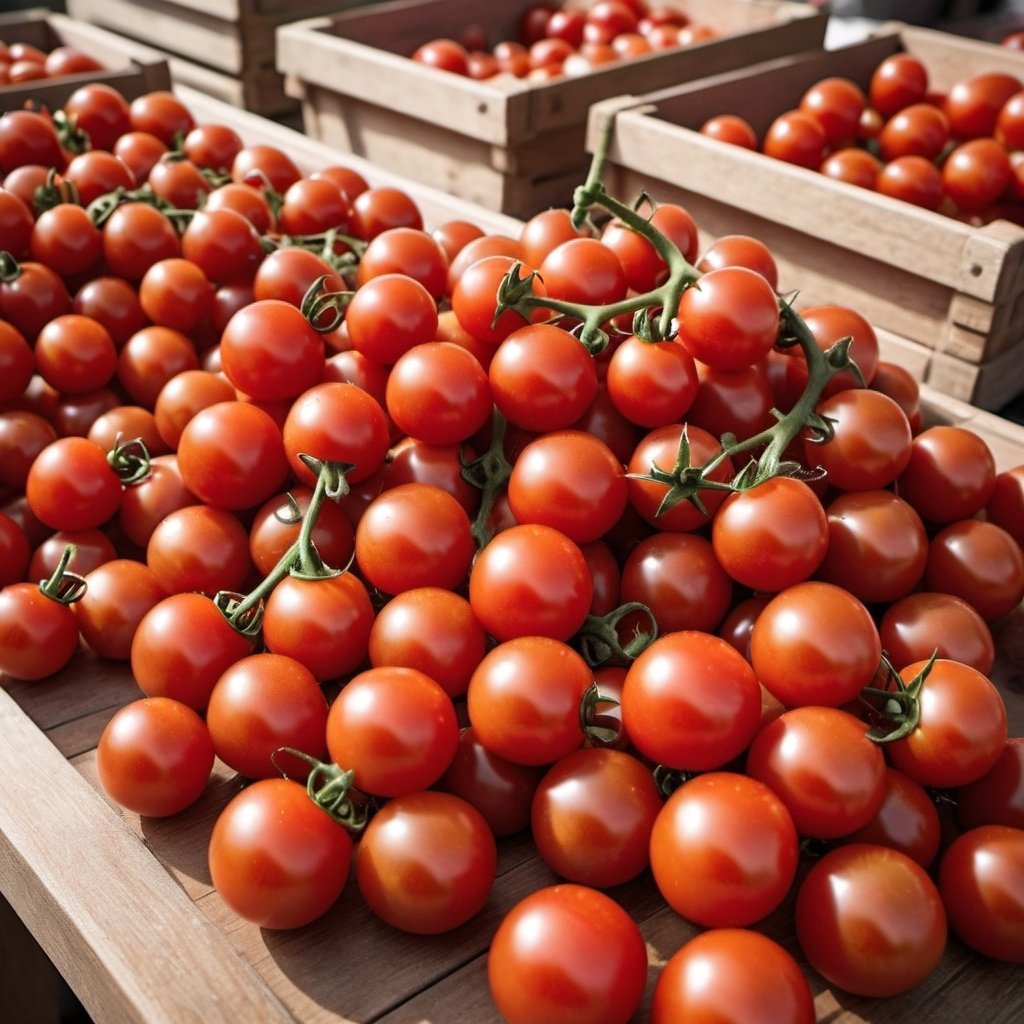
Characteristics of Cherry Tomatoes
- Size and Shape: Cherry tomatoes are small, round, and about the size of a golf ball. They look like cherries.
- Color: They come in red, yellow, orange, and even purple. This makes them look good in dishes.
- Flavor: Cherry tomatoes are sweet and juicy. They have more sugar than bigger tomatoes.
- Texture: They have smooth, firm skin and are juicy inside. This makes them good for salads and snacks.
- Growth: Cherry tomato plants produce a lot of fruit. They can grow in containers, gardens, and small spaces.
- Nutritional Value: Cherry tomatoes are high in vitamins A and C and low in calories. They also have antioxidants.
- Uses: Cherry tomatoes are good for salads, roasting, grilling, and garnishing. They are often used in Mediterranean and Italian cooking.
- Season: Cherry tomatoes are in season in the summer but can often be found all year in stores.
- Varieties: There are many types of cherry tomatoes, like Sweet 100, Sun Gold, and Black Cherry. Each looks and tastes different.
Specialty Cherry Tomatoes:
Small, bite-sized fruits with a sweet, tangy flavor, perfect for salads and snacking.
Advantages Cherry Tomatoes:
Gardening: Versatile and can be grown in gardens, raised beds, and containers. Fast-maturing and produce abundant yields.
Culinary: Great for fresh eating, adding color and flavor to dishes.
Disadvantages Cherry Tomatoes:
- Gardening: Can become unruly if not properly pruned and supported. Susceptible to splitting if not harvested regularly.
- Space: Require space and support to manage their growth in containers.
3. Roma Tomatoes
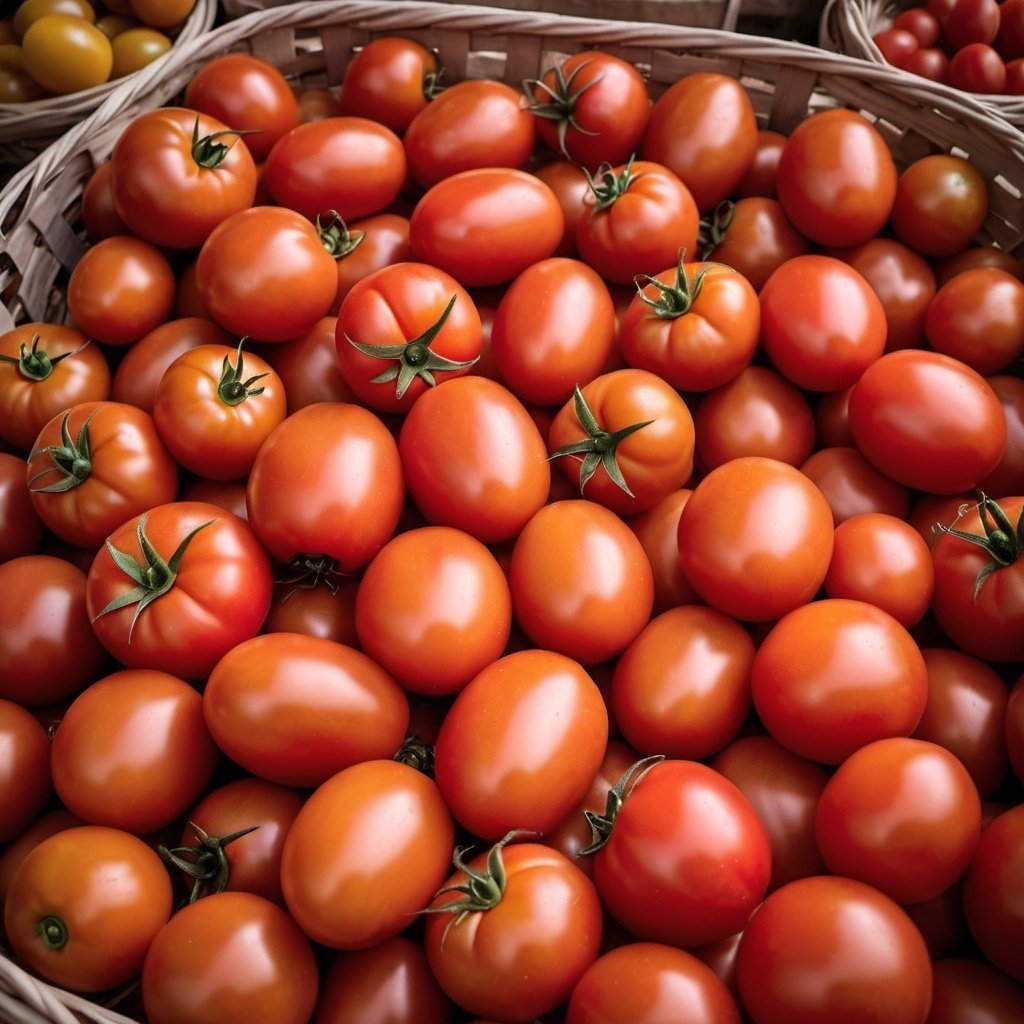
Characteristics of Roma Tomatoes:
- Shape: Roma tomatoes have an oval or plum-like shape.
- Size: They are medium-sized, typically about 3 inches long.
- Texture: Their flesh is dense and firm.
- Taste: Roma tomatoes have a rich, tangy flavor.
- Seeds: They contain fewer seeds compared to other tomato varieties.
- Use: Ideal for sauces, pastes, and canning due to their meaty texture.
- Color: Usually bright red when ripe.
- Shelf Life: They have a longer shelf life than many other tomatoes.
Specialty Roma Tomatoes:
Also known as plum tomatoes, they have thick flesh and few seeds, ideal for sauces and canning.
Advantages Roma Tomatoes:
- Gardening: Suitable for gardens and raised beds, compact growth habit.
- Culinary: Excellent for cooking, making sauces, and preserving due to their dense texture.
Disadvantages Roma Tomatoes:
- Gardening: Limited variety for fresh eating compared to other types. Susceptible to blossom end rot if calcium levels are not managed.
- Space: May require more space and support in containers.
4. Heirloom Tomatoes
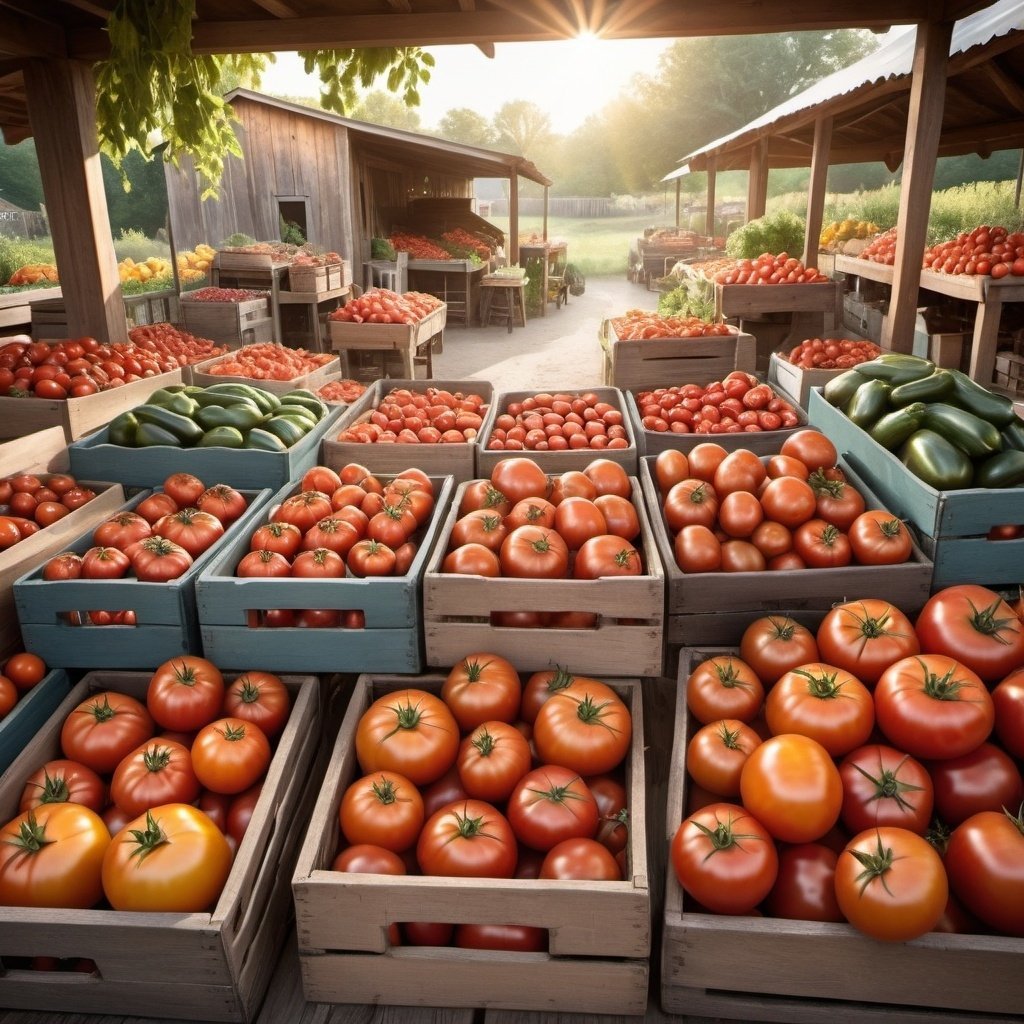
Characteristics of Heirloom Tomatoes:
- Unique Shapes and Colors: Heirloom tomatoes or heritage tomatoes come in various shapes and colors, from red and yellow to purple and green. Their appearance is often more irregular compared to regular tomatoes.
- Rich Flavor: These tomatoes are known for their rich, complex flavors, which can be sweet, tangy, or even smoky. Each variety has a distinct taste.
- Thin Skin: Heritage tomatoes usually have thinner skin, making them more delicate. This characteristic also contributes to their superior taste.
- Open-Pollinated: They are open-pollinated, meaning they rely on natural pollination from insects or wind. This helps maintain their diverse genetic traits.
- Historical Varieties: Many heirloom tomatoes have been passed down through generations, often with specific family or regional histories. They are prized for their heritage and traditional cultivation methods.
- Susceptible to Disease: They can be more prone to diseases and pests compared to hybrid varieties. This can make them a bit more challenging to grow.
Specialty Heritage tomatoes:
Open-pollinated varieties passed down through generations, known for their unique flavors, colors, and shapes.
Advantages Heirloom Tomatoes:
- Gardening: Offer a wide variety of choices for different climates and gardening conditions. High flavor quality.
- Culinary: Unique flavors and appearances make them highly sought after for fresh eating and gourmet cooking.
Disadvantages Heirloom Tomatoes:
- Gardening: Often less disease-resistant than hybrid varieties and can have lower yields.
- Space: Some heirlooms can be quite large and require ample space and support.
5. Patio Tomatoes
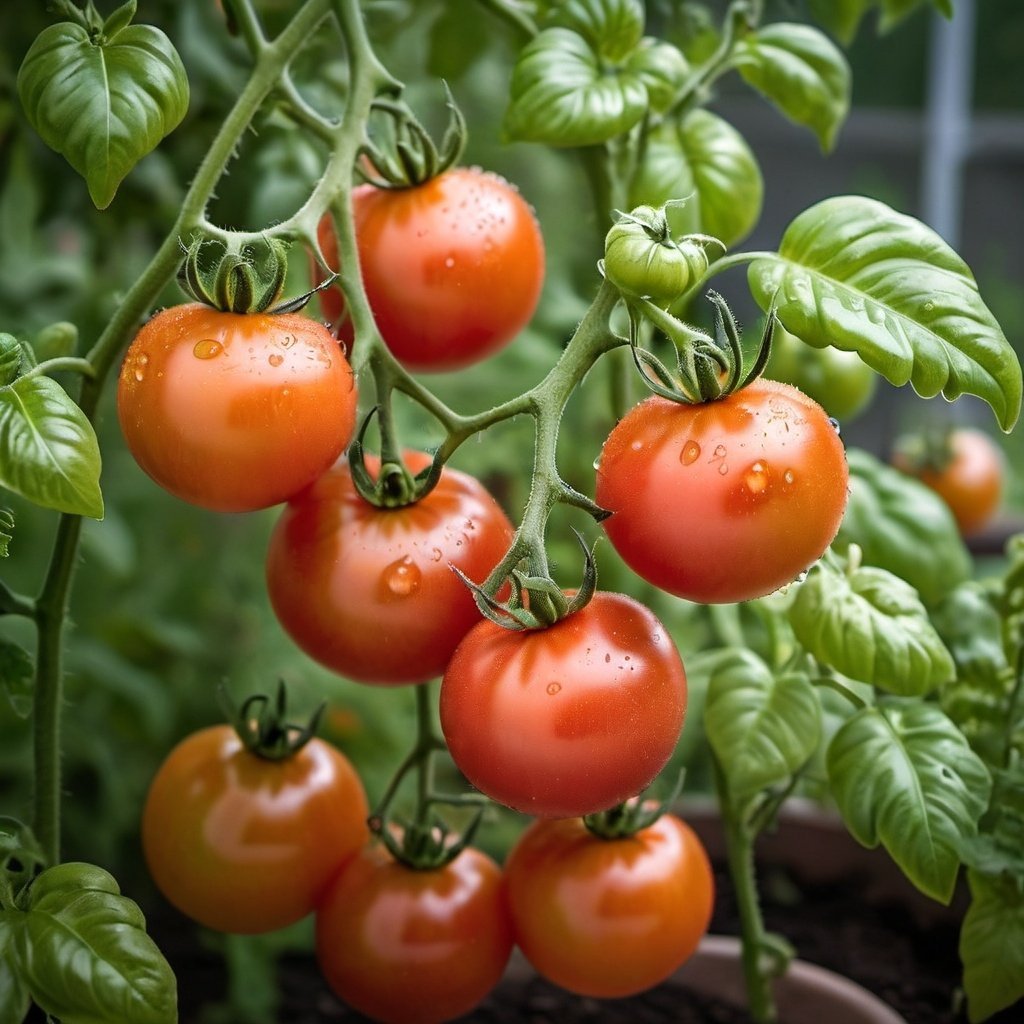
Characteristics of Patio Tomatoes:
- Compact Size: Patio tomatoes are small plants, perfect for growing in containers on balconies or small gardens.
- Dwarf Varieties: They are usually dwarf or determinate types, meaning they grow to a fixed height and produce fruit in a short period.
- Early Maturity: These tomatoes often mature faster than other varieties, providing a quick harvest.
- Abundant Yield: Despite their small size, they produce a good number of tomatoes.
- Easy Care: They require minimal maintenance and are generally easy to grow, making them ideal for beginners.
- Flavorful Fruit: The tomatoes are known for their good taste, often sweet and juicy.
- Sunlight Needs: They need plenty of sunlight, ideally around 6-8 hours a day.
- Disease Resistant: Many patio tomato varieties are bred to be resistant to common tomato diseases.
Specialty Patio Tomatoes:
Dwarf or compact varieties bred specifically for container gardening.
Advantages Patio Tomatoes:
- Gardening: Perfect for small spaces, balconies, and patios. Easy to manage and require less staking.
- Culinary: Convenient size for fresh eating and small batches of cooking.
Disadvantages Patio Tomatoes:
- Gardening: Limited fruit size and yield compared to larger varieties.
- Space: While great for small spaces, they may not satisfy those seeking larger harvests.
6. Grape Tomatoes
Characteristics of Grape Tomatoes:
- Small Size: Grape tomatoes are small and oval-shaped, resembling grapes.
- Sweet Flavor: They are known for their sweet taste, which is milder than regular tomatoes.
- Firm Texture: Their firm skin and flesh make them less likely to burst compared to other small tomatoes.
- Versatile Use: Ideal for salads, snacking, and garnishing due to their bite-sized nature.
- High Nutritional Value: Rich in vitamins A and C, potassium, and antioxidants.
- Long Shelf Life: They tend to last longer than other types of tomatoes when stored properly.
Specialty Grape Tomatoes:
Small, elongated fruits with a firm texture and sweet flavor, similar to cherry tomatoes but more uniform in size.
Advantages Grape Tomatoes:
- Gardening: Adaptable to various gardening methods, including containers and hanging baskets. Prolific producers.
- Culinary: Excellent for fresh eating, salads, and roasting.
Disadvantages Grape Tomatoes:
- Gardening: Can require frequent harvesting and pruning to keep plants manageable.
- Space: Require adequate support even in containers to prevent sprawling.
7. Determinate Tomatoes
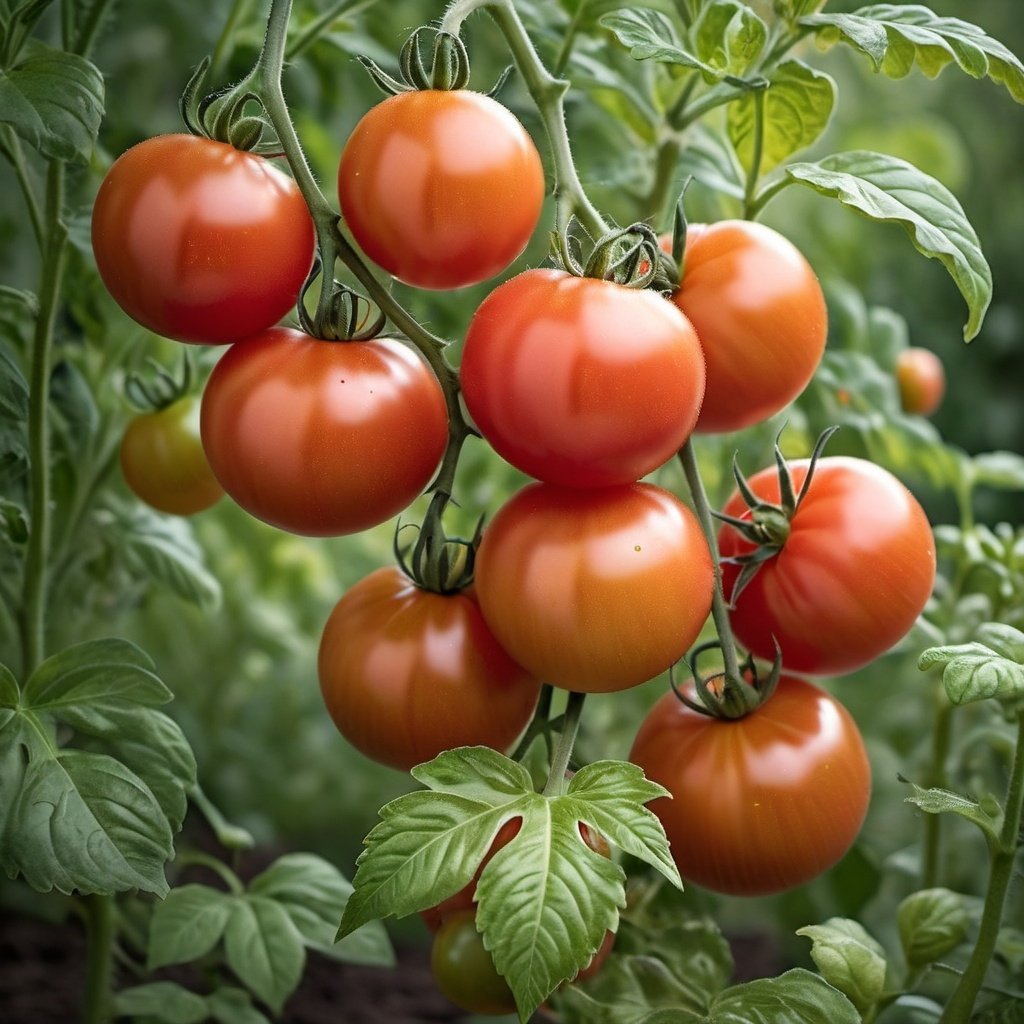
Characteristics of Determinate Tomatoes:
- Growth Pattern: Determinate tomatoes grow to a specific height, usually around 3-4 feet, and then stop. They tend to have a bushy growth habit.
- Fruit Production: These tomatoes produce all their fruit in a short period, typically over a few weeks. This makes them ideal for canning and processing.
- Pruning Needs: They require minimal pruning compared to indeterminate varieties. This makes them easier to manage for novice gardeners.
- Support Requirements: Determinate varieties often do not need staking or extensive support. Their sturdy, compact growth makes them self-supporting.
- Ripening Time: All the tomatoes tend to ripen around the same time. This can lead to a large, single harvest.
- Space Efficiency: They are well-suited for small gardens or container growing due to their compact size. They do not spread out as much as indeterminate varieties.
- Variety Examples: Common determinate tomato varieties include ‘Roma,’ ‘Celebrity,’ and ‘Rutgers.’ These are popular for their predictable growth and harvest patterns.
Specialty Determinate Tomatoes:
Also known as bush tomatoes, they grow to a fixed size and produce a single, concentrated harvest.
Advantages Determinate Tomatoes:
- Gardening: Ideal for container gardening and small spaces. Easier to manage due to their compact growth.
- Culinary: Good for canning and preserving because the fruit ripens all at once.
Disadvantages Determinate Tomatoes:
- Gardening: Shorter production period means a limited window for harvesting.
- Space: Although space-efficient, they may not provide a continuous supply of tomatoes throughout the season.
8. Indeterminate Tomatoes
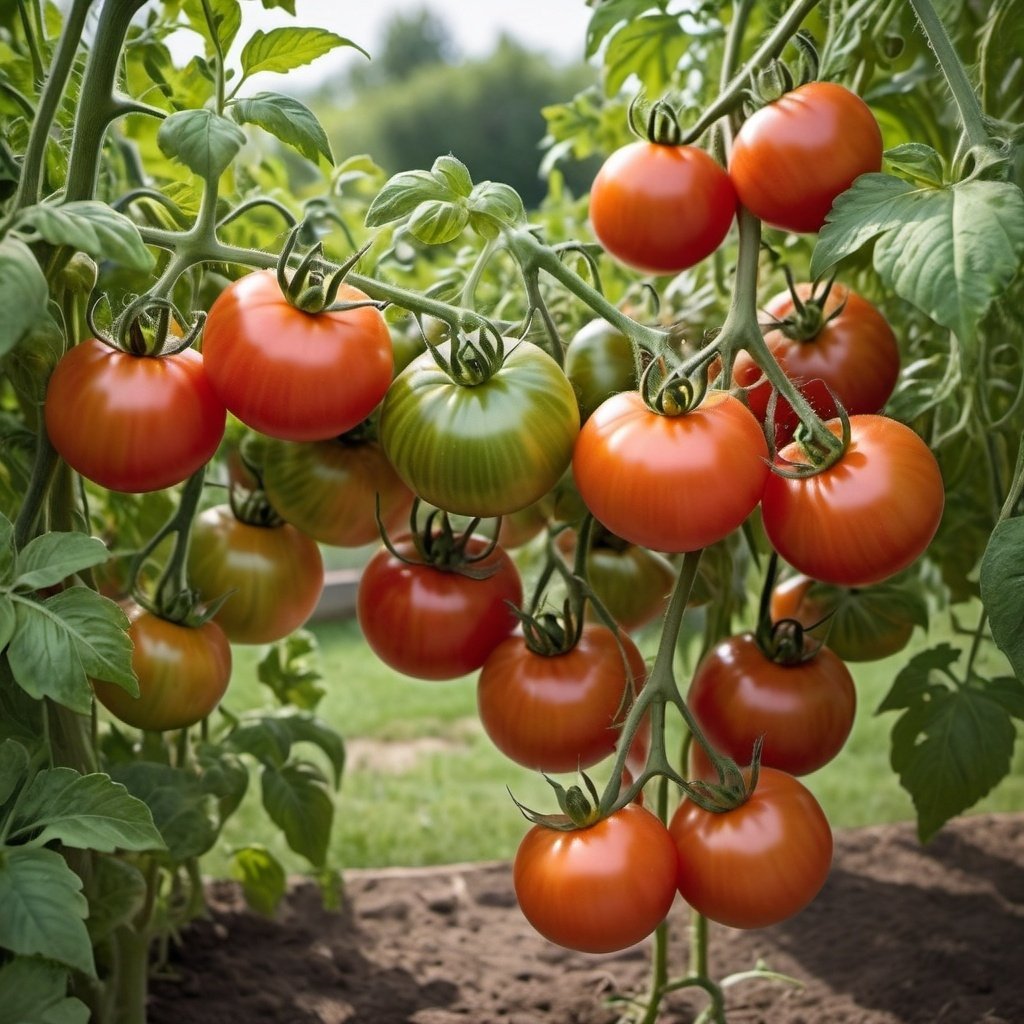
Characteristics of Indeterminate Tomatoes:
- Continuous Growth: Indeterminate tomatoes keep growing and producing fruit throughout the growing season until frost stops them.
- Vine-like Habit: They grow like vines, often needing support such as stakes or cages to keep the plants upright.
- Extended Harvest: These plants produce tomatoes over a long period, providing a steady supply rather than a single large harvest.
- Pruning Needed: Regular pruning of side shoots can help manage their growth and improve fruit quality.
- Larger Plant Size: They generally grow taller and larger than determinate varieties, often reaching heights of 6-10 feet or more.
Specialty Indeterminate Tomatoes:
Indeterminate tomatoes boast an extended growing season, continuously producing fruit until frost hits. Their sprawling vines require sturdy support and diligent pruning to maximize yields. This trait makes them a favorite among home gardeners seeking a steady supply of fresh tomatoes throughout the summer.
Advantages Indeterminate Tomatoes:
- Extended Harvest: Their continuous fruit production ensures a prolonged harvest season, providing a steady supply of fresh tomatoes over several months.
- Continuous Growth: Unlike determinate varieties that stop growing after reaching a certain height, indeterminate tomatoes keep growing throughout the season, resulting in larger plants and potentially higher yields.
- Higher Yields: Due to their continuous growth and fruiting habit, indeterminate tomatoes can produce larger quantities of tomatoes compared to determinate varieties.
- Versatility: Their sprawling vines make them suitable for various growing methods, including trellising, staking, or caging, allowing for flexibility in garden layouts and space utilization.
- Fresher Flavor: Because the fruits ripen gradually over time, indeterminate tomatoes tend to have a fresher flavor compared to those harvested all at once from determinate varieties.
Disadvantages Indeterminate Tomatoes:
- Gardening: Require more space, staking, and maintenance. Can become unwieldy if not properly managed.
- Space: Not suitable for small containers or limited spaces.
9. Plum Tomato
Characteristics of Plum Tomato
- Shape and Size:
- Plum tomatoes are oval or cylindrical in shape, unlike the round globe tomatoes.
- They are generally smaller, typically ranging from 2 to 4 inches in length.
2. Texture and Flesh:
- They have a thick, meaty flesh with fewer seeds and less water content.
- The skin is smooth and firm, making them ideal for cooking.
3. Color: They are usually a vibrant red when fully ripe, though some varieties can be yellow or orange.
4. Flavor: Plum tomatoes offer a rich, slightly sweet flavor, making them perfect for sauces and pastes.
Specialty Plum Tomato
- Ideal for Sauces: Due to their low moisture content and high proportion of flesh, plum tomatoes are excellent for making tomato sauces, pastes, and purees. They break down easily when cooked, resulting in a thick, flavorful sauce.
2. Versatile Culinary Use:
- They are commonly used in Italian cuisine, particularly in pasta sauces, soups, and stews.
- Fresh plum tomatoes are also great for roasting, grilling, or incorporating into salads and salsas.
3. Canning and Preserving: Their firm texture makes them suitable for canning and preserving, ensuring that the rich tomato flavor can be enjoyed year-round.
4. Nutrient-Rich: Plum tomatoes are rich in vitamins A and C, potassium, and antioxidants like lycopene, which is beneficial for heart health and has anti-cancer properties.
Advantages Plum Tomato
- Culinary Versatility: Their unique texture and flavor make them suitable for a wide range of dishes, from fresh salads to cooked sauces.
2. Health Benefits: Packed with essential nutrients and antioxidants, plum tomatoes support overall health and well-being.
3. Ease of Use: Their firm flesh and fewer seeds make them easier to chop, dice, and process compared to other tomato varieties.
4. Long Shelf Life: They tend to have a longer shelf life when stored properly, especially when canned or preserved.
Disadvantages Plum Tomato
- Limited Fresh Eating Appeal: While excellent for cooking, their dense texture and lower water content might not be as appealing for fresh eating compared to juicier tomato varieties.
2. Seasonal Availability: Fresh plum tomatoes are typically more available in the summer, and out-of-season tomatoes might lack the same flavor and quality.
3. Potential for Over-Ripening: They can over-ripen quickly if not stored properly, leading to a loss of flavor and texture.
4. Price Variability: Depending on the region and season, plum tomatoes can sometimes be more expensive than other types of tomatoes.
10. Green Tomato
Characteristics of Green Tomatoes:
- Color and Texture: As the name suggests, green tomatoes are typically unripe fruits that haven’t reached their full red color. They are firm and often more dense compared to ripe tomatoes.
2. Flavor: Green tomatoes have a tangy, slightly acidic taste, which is less sweet than their ripe counterparts. This characteristic makes them ideal for dishes where a balance of acidity is desired.
3. Versatility: They can be used in both cooked and raw forms, lending themselves well to frying, pickling, or as an ingredient in salsas and relishes.
Specialty of Green Tomatoes:
- Fried Green Tomatoes: Perhaps the most famous dish featuring green tomatoes is the southern classic, fried green tomatoes. Slices of green tomatoes are coated in cornmeal or breadcrumbs and fried until crispy, offering a delightful contrast of textures.
- Pickling: Green tomatoes are excellent candidates for pickling due to their firmness and tangy flavor. They retain their crunch even after pickling, adding a zesty bite to sandwiches and salads.
- Salsas and Chutneys: Chopped green tomatoes can be used to make flavorful salsas and chutneys, offering a refreshing alternative to traditional tomato-based sauces.
Advantages of Green Tomatoes:
- Extended Shelf Life: Green tomatoes have a longer shelf life compared to ripe tomatoes, making them a practical choice for storage and transportation.
- Lower Sugar Content: They contain less sugar than ripe tomatoes, which can be advantageous for those monitoring their sugar intake or looking for a less sweet flavor profile in dishes.
- Cooking Versatility: Their firm texture holds up well to cooking methods like frying and baking, allowing for diverse culinary applications.
Disadvantages of Green Tomatoes:
- Tartness: The tartness of green tomatoes may not appeal to those who prefer sweeter flavors in their dishes, especially when eaten raw.
- Potential for Tough Texture: Overcooking green tomatoes can lead to a tough texture, requiring careful monitoring during cooking to achieve optimal results.
- Limited Availability: Depending on the season and location, finding green tomatoes may be more challenging compared to ripe tomatoes, which are available year-round in many regions.
By understanding the specialties, advantages, and disadvantages of these tomato varieties, you can choose the best types for your gardening situation and culinary needs. Happy growing!
